|
|
|
|
|
|
|
|
|
|
|
|
 |
|
|
John's residence -- shared with lecturer/writer/university-faculty wife Martine and their piano-playing daughter Roxanne -- is a mere foot walk from the Scandinavian-vibe downtown. You cross the freeway over the catwalk past the cathedral, meander leisurely through the sculpture gardens with their steaming greenhouses and silently thank the inner-city planners for "wasting" precious real estate on parks, greenery and "people space".
Nestled against a carved-out hill at the end of a cul-de-sac, tall trees surround the Stronczer property to give it a distinct in-the-country feel. Being part of the local fox highway -- I saw one traipsing past, just a few stealthy feet removed from the glassed kitchen door -- only adds to the considerable charm of the house. It's beautifully decorated, modern yet comfortable, sophisticated yet not ostentatious - European, for short, with squirrels stacking up for winter outside while the resident writer (fluent in French and English, more than passable in Russian and German) pours over Medieval charts and maps concluding her next manuscript.
As the following images attempt to convey, this house breathes style as its music and movie systems spell quiet finesse. The connection is obvious. I believe that you can only write the way you think. Designing and voicing audio equipment is equally embroiled in personal "head space", taste and priorities. Those express themselves in personal environments. Truly, entering a person's intimate and private space says more about them than so many fancy words. With thanks to the two ladies of the house for their gracious hospitality, let's take a look around, shall we? |
|
|
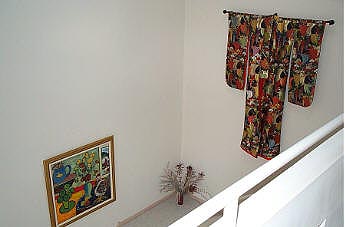 |
|
|
|
|
 |
|
|
The entry opens to the upper loft [left]
|
|
|
|
|
|
while a long corridor on the main floor [right] flows past the kitchen and bedroom and ends in the dining room to the left and the listening/living room to the right
|
|
|
|
 |
|
|
|
|
This sound room benefits from two-story ceilings and the open floor space to create a rather cavernous air volume for the speakers to fill |
|
|
|
|
|
|
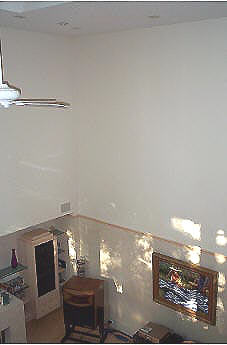 |
|
|
 |
|
|
|
|
|
|
|
[right] This picture was taken from the loft to portray ceiling height - you're looking at the left speaker as seen from Martine's studio
|
|
|
|
 |
|
 |
|
Remember the happy cook? John designs his components to please himself, just as much as his customers. No surprise then to find Bel Canto pieces in this upstairs system as well as in the Home Theater rig below. Two bridged eVo2 amps are fed from a PRe6 preceded by a Sony ES 555 SACD player (Japanese issue, not available in the US) passing the digits to a DAC2 hidden behind the MR-74 McIntosh tuner. Vinyl -- next to single-ended zero-feedback amplifiers the other most highly decorated audiophile proof that someone's truly embraced their music -- is handled by a Micro Seiki table with RX1500 motor controller and vacuum pump stabilizer, a Fidelity Research arm and head shell and MC170 Audio Technika cartridge.
Wiring is by Analysis Plus (Solo Crystal ICs and Solo Oval 8 single-wire speaker), with two Eichmann eXpress power cords on the eVos and a Richard Gray Power Company "flywheel" filter on the low-level components. |
|
|
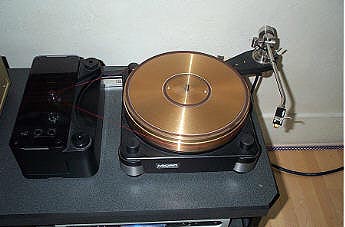 |
|
 |
|
John's previous Altec Voice of the Theater horns have retired to the garage. They made room for a very rare sight on US soil - a pair of top-line TAD 2404, 15-inch two-way horn-loaded studio monitors. |
|
|
 |
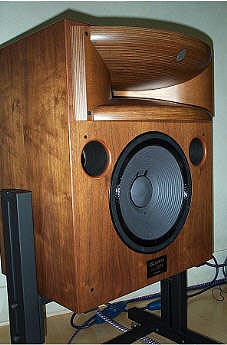 |
|
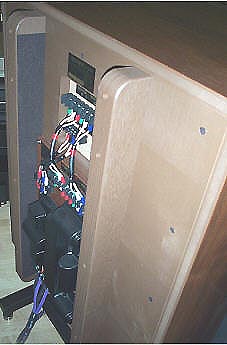 |
|
|
A division of Pioneer, TAD's engineers -- a long time ago -- were assigned the task to combine the best of Altec-Lansing's and JBL-Pro's legacies in the professional arena and "take things to the next and ultimate level".
TAD drivers are likely the most expensive production transducers extant. Forget a few hundred dollars for an Esotar2 tweeter. Add a zero. That's just for the driver.
Admittedly, the pictures here truly don't do the TAD's justice. By a long shot. The level of workmanship on the wooden horns, the exposed crossovers, the tweaky tuning touches - all spell deeply esoteric Japanese underground audiophilia. Except that state-of-the-art Skywalker Ranch, by using TADs exclusively in their reference mastering as well as theater demonstration facilities, expands the narrow meaning implied with just one potent example. And then there are a few well-heeled and dedicated music lovers on the consumer side who've perceived their faint siren call and responded.
But overall it's fair to pronounce the TAD division victim of corporate oversight: Spend lots of money on cutting-edge R&D. Produce certifiably exquisite results. Home free? Perhaps if it was you and I. Instead, now stop promoting your work. Why? Perhaps because there's already too much gold spilling through the rafters from the mainstream ventures. Perhaps because the pressure of having to turn a profit has vanished. This leaves the engineers at liberty, to pursue their craft sans the handicap of the usual pencil pricks shouting commercial viability, bottom-line, profit sharing and conceptual feasibility.
Having never heard TADs beyond their underground repute -- Phil Jones whom I talk to on occasion is equally enthused about their drivers -- I was in for an experience. Not the last word in ultimate bass extension or impact compared to my Avantgarde Duos (in a far smaller room); and with less extreme image density than what I get out of the Audiopax amps; they excelled at being utterly non-audiophile. No undue emphasis in any particular area to distract from the music; solidly planted life-size images without edging; no dynamic compression when listening to the Stones SACD remaster at "lively" volumes; a breathy quality of unbounded space no doubt mirroring the very real space all around - in short, an exercise in untainted naturalness. Ease. Unobtrusive, sheer listenability. Get-out-of-the-way, let-the-music-speak stuff.
And this, as much as anything else, was the core confirmation I took away after hearing what John Stronczer uses for his reference - what epitomizes the things he listens for and values. Investigating his software collection only underscored this further: Select top-drawer Jazz, Classical -- the good stuff, not the showoff blockbusters -- plenty of French fare not readily available here but a reminder that he went to school in Paris, is married to a French girl and could readily see himself retiring in the South of France with a pad in the capital.
My well-known appreciation for Bel Canto gear has now simply gathered that last bit of insight. My visit explained to me why it sounds as it does. Its designer values naturalness above the many audiophile crossword puzzle terms that pepper reviewer vocabulary - because it gives you something to talk about beyond "it didn't sound like anything in particular, sorry, I just got lost in the music - could you shut up, please, you're interrupting!".
I also found it telling that Stronczer uses high-quality -- but not expensive out-there -- cables and doesn't monkey around with pucks, cones, voodoo chants or fairy dust (he does use a set of Aurios below the speakers). Put differently, to get good sound from his gear doesn't require any of these extras. He's also compared SACD-direct feeds to taking the CD layer through his DAC2. He prefers the latter. And it's not like he couldn't switch back. If -- like me -- you're an overdue late adopter, perhaps this li'l tidbit can squelch any concerns you may inflict upon yourself, for apparent unwillingness to get with the game. There are other ways.
|
|
|
|
 |
 |
|
|
|
|
|
 |
|